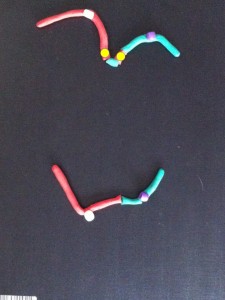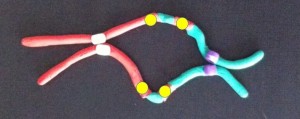Barbara McClintock published a paper describing the breakage-fusion-bridge (BFB) cycle in 1939. She studied the genetics of maize, and many of her ideas were well before their time. Like many such profound leaps in thinking, the BFB cycle took a long time to catch on. She wrote in 1973, “I stopped publishing detailed reports long ago when I realized, and acutely, the extent of disinterest and lack of confidence in the conclusions I was drawing …One must await the right time for conceptual change.” Her work was appreciated much later and she was awarded a Nobel Prize in 1983 for her discovery of “jumping genes“.
Fast forward 75 years and we have an unexpected benefit of this seemingly obscure plant research. It can help us understand some of the mechanisms involved in cancer. The rediscovered breakage-fusion-bridge cycle can make cancer very aggressive, and it may be much more common than we think. Centromeres (see below) are the key to the BFB cycle, but centromeres are largely overlooked, both in research and diagnostics.
This is how it works.
The breakage-fusion-bridge cycle is one way that chromosome division can go wrong. Very wrong, in the sense that it can cause the chromosomes to keep changing, and this can cause cancer. I’ve put together this animation, which illustrates the breakage-fusion-bridge cycle. There’s a summary of normal chromosome division on my blog, chromosomesandcancer.com.
A human chromosome with two centromeres is abnormal. One way this can happen is when the telomeres become degraded (see a previous post). Chromosomes with two centromeres are not unusual in cancer cells. In fact they’re probably a lot more common than we think, because in both research and diagnostic labs the centromeres are usually not looked at.
To recap, a normal chromosome has one centromere. Before the chromosome divides, the two identical halves (chromatids) are held together at the centromere. When the chromosome divides the centromere splits into two halves, the chromatids become the new chromosomes, and the centromeres take the two new chromosomes in different directions into the two new daughter cells.
So what happens if there are two centromeres? If they’re both aligned so that they head in the same direction it’s not a problem – together they take a complete new chromosome with them. The closer the centromeres are together the more likely this is.
Now follow the pictures and their captions. These describe chromosome division in an abnormal chromosome with two centromeres. In particular, follow the yellow dots.
If the yellow gene in the pictures is a cancer gene (“oncogene”) the cell with extra copies might grow and multiply faster than its neighbors. We call this natural selection – the cells that can grow faster than their neighbors become more common, which means the genetic change causing that is undergoing “positive selection”. Yes, the cells in our body can evolve and we know this best as cancer.
All this change happens between the two centromeres where the bridge forms. So if we find a chromosome with this type of change on one side of the centromere only, it’s a clue that this might have been caused by the breakage-fusion-bridge cycle.
Many (perhaps most) images demonstrating the BFB cycle show a different version – where the abnormal chromosome is created by breakage and joining together of the two chromatids of one chromosome. Check this out on Google Images (search for breakage-fusion-bridge). But I think the version I’ve shown here – where two different chromosomes join – is probably more common. It’s the more common version in my experience with acute myeloid leukemia.
(This is a modified version of a post in my blog.)
Further Reading:
B. McClintock 1939. The Behavior in Successive Nuclear Divisions of a Chromosome Broken at Meiosis. Proc Natl Acad Sci U S A. 1939 August; 25(8): 405–416.
M. Kinsella and V. Bafna 2012. Combinatorics of the Breakage-Fusion-Bridge Mechanism. J Comput Biol. 2012 June; 19(6): 662–678.
R. MacKinnon and L. Campbell 2011. The Role of Dicentric Chromosome Formation and Secondary Centromere Deletion in the Evolution of Myeloid Malignancy. Genetics Research InternationalVolume 2011 (2011), Article ID 643628.









